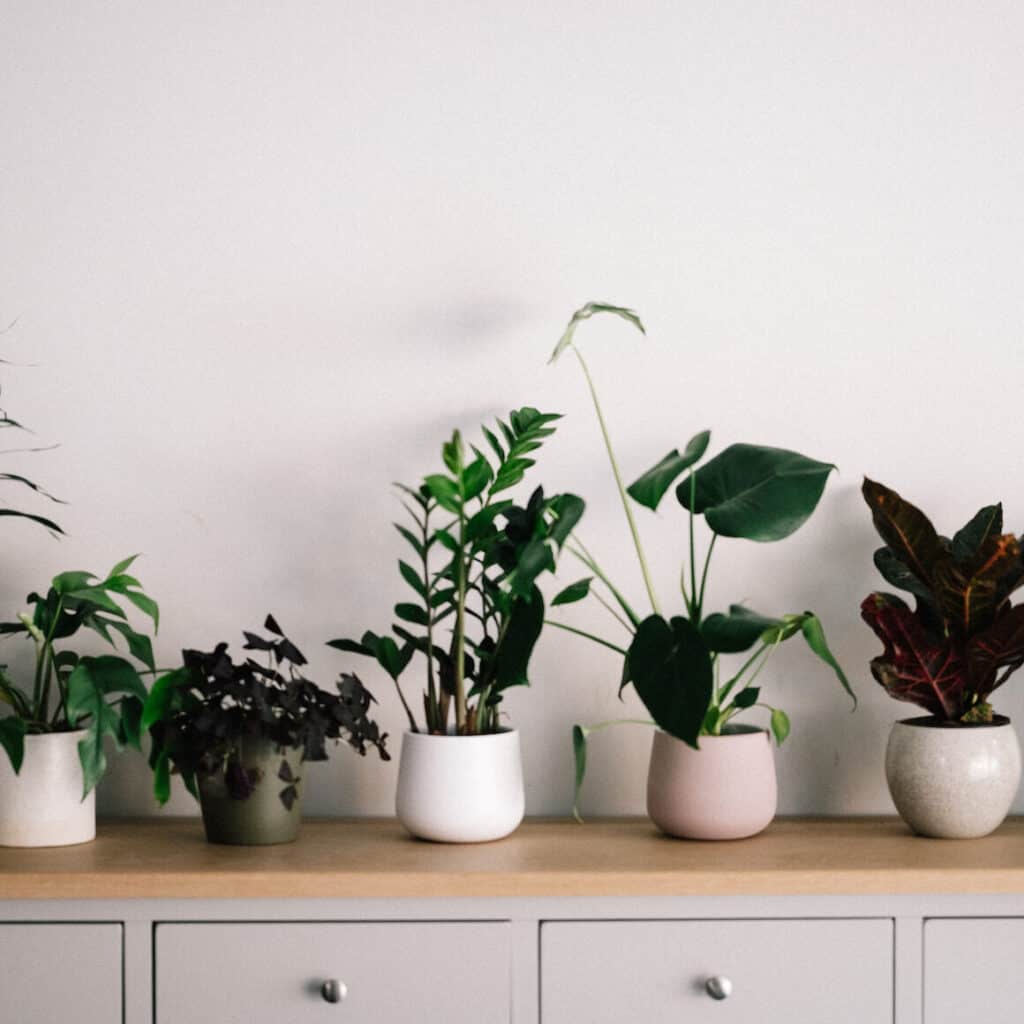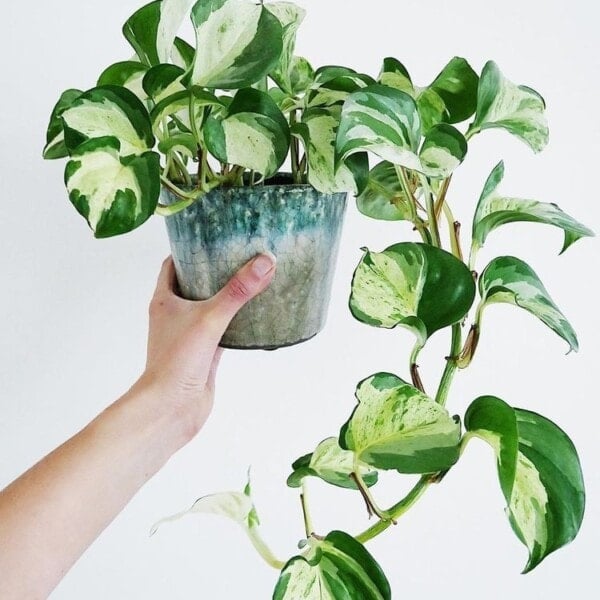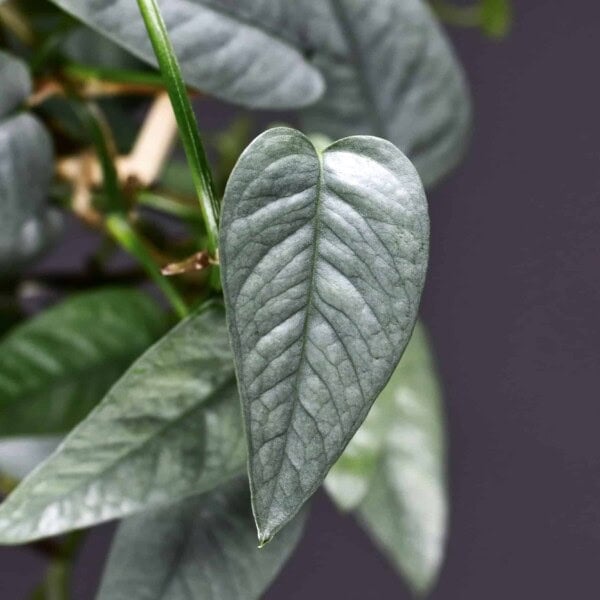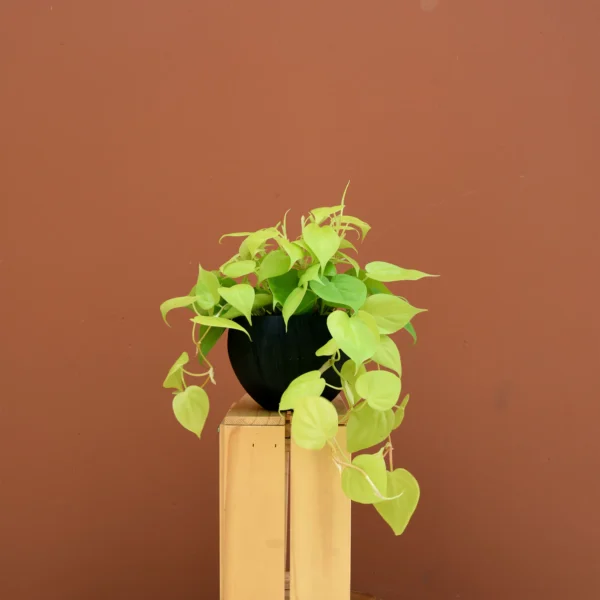As a passionate plant parent, I’m always on the hunt for new captivating plant babies to incorporate into my indoor garden. Bonus points go to plants that are no-fuss, with sculptural foliage that doubles as great decor, and the Zanzibar Gem Plant does all of these things.

The best part is that the Zanzibar house plant—is a plant that you are almost guaranteed to have success with. Also known as the Zanzibar Gem Plant, the Zamioculcas zamiifolia, and ZZ amongst many others, is very low-maintenance making it one of my top recommendations to beginner plant parents. They are nearly as easy as other well known low maintenance plants such as the pothos, or snake plant.

This resilient gem is literally perfect for incorporating into your home for added life, and sculptual charm: be it your living room, kitchen, powder room, or home office.
Table of Contents
- What is a Zanzibar Plant?
- Zanzibar Gem Plant Overview
- Different Varieties of Zanzibar Gem Plants
- Why Are ZZ Plants So Popular?
- Why The ZZ Plant is An Excellent House Plant
- Four Key Benefits of ZZ Plants
- Keeping Your Zanzibar House Plant Happy and Healthy: Care Guide
- Long-term Care & Maintenance
- You might also like
- Pests & Other Potential Problems
- Grow Your Own Zanzibar Plant: Propagation Techniques
- Potting and Repotting of ZZ Plants
- Common Problems With ZZ Plants and How To Fix Them?
- Preventive Care For Zanzibar Health
- Where to Place Zanzibar Gem Plants?
- Take The First Step: Get Your ZZ Plant Now
- Commonly Asked Quetions about Zanzibar Gem Plants
- A Few Final Thoghts on the Zanzibar Gem Plant
What is a Zanzibar Plant?
The Zanzibar (Zamioculcas zamiifolia) plant is a beautiful easy-care plant. Originating in Eastern Africa, it can be found in Kenya and South Africa. Its appeal lies in its gracefully arching stems and shiny dark green leaves.
Zanzibar plants offer maximum reward with minimum care as they are highly regarded for their low-maintenance nature and tolerance of low light and even dry spells. I have three and they pair great nestled up to all types of indoor ferns, and succulents.

Zanzibar Gem Plant Overview
| Common Names | Zanzibar Gem, ZZ Plant |
| Scientific Name | Zamioculcas Zamiifolia |
| Plant Family | Araceae |
| Plant Type | Tropical Perennial |
| Maximum Size | 2–3 feet (height) |
| Climate Preferences | Warm, frost-free |
| Native Habitat | East Africa |
| Flowers | Small (Yellow, Green, or White) |
| Growing Season | Spring |
| Leaves | Dark Green, Glossy |
| Soil Requirements | Well-draining (Neutral to Acidic PH) |
| Toxicity | Toxic if Ingested (Human and Pets) |
Different Varieties of Zanzibar Gem Plants
ZZ plants offer more variety than many realize, with over fifteen known cultivars and an easy care routine. While some of them are readily available, others are quite rare. Let’s explore a few of the more accessible ZZ plant types.
1. ZZ Plant
When people say “Zanzibar Plant”, they’re usually referring to the classic ZZ plant. It is a low-maintenance houseplant with shiny, dark green leaves that grow straight on strong stems. In ideal conditions, it can mature to a height of 3–4 feet.
2. ZZ Plant Raven
ZZ ‘Raven’ is a unique and slow-growing variety of Zanzibar plant. Its distinguishing feature is its leaves, which transition from green to a deep purple or maroon, and are slightly smaller. Raven can reach a maximum height of about 2.5 feet, adding a dramatic touch to your indoors.

3. ZZ Plant Zenzi
The ZZ plant ‘Zenzi’ is a miniature version, perfect for small spaces. It is a dwarf variety with compact growth and smaller leaves compared to the standard ZZ. This plant maintains a petite size, within 10 to 12 inches in height. Its small size and tidy growth make it an ideal centerpiece for a dining room table, without overwhelming the place.

4. Supernova ZZ Plant
ZZ Supernova is a striking cultivator of the famous Zanzibar plant. It stands out with its elongated, slender, glossy dark green leaves. The plant has a compact and bushy growth with a maximum height of 12 to 18 inches.

Why Are ZZ Plants So Popular?
ZZ is one of those houseplants that are hard to kill. Known for its resilience, it is a forgiving choice for busy individuals who have little time.
Unlike delicate houseplants, Zanzibar tolerates neglect, withstands low-light situations, and sustains long periods of drought. Its thick, glossy leaves are coated with a natural wax, which minimizes water loss through transpiration.

The ZZ plant’s unique water-saving photosynthesis, similar to that of succulent plants, allows it to conserve moisture by absorbing carbon dioxide at night. This adaptability makes it perfect for dry, indoor environments. It lets you enjoy the beauty of indoor plants without the stress of constant upkeep. Whether you are a beginner or a seasoned plant enthusiast, ZZ ensures a flourishing green presence even with minimal effort.
Why The ZZ Plant is An Excellent House Plant
There are a number of reasons if we’re being honest, but I’ll try to keep things quick and concise. After all, I know you guys just can’t wait to go over how to grow your own! Alright, here’s the quick and easy answer.
They don’t require a lot of light, meaning you can place them nearly anywhere in your home. This is part of what makes them especially popular in small spaces, with him light.
Their glossy green leaves can meld perfectly into nearly any space. Since they don’t generally flower, it’s easy to pair them with more colorful flowers nearby. The darker oval-shaped leaves complement other plants well.
Pin this article
Pin It Now
The pest risks are minimal. Like any plant, pests and diseases always pose a certain level of risk, but those levels are relatively low with this plant.
They can last up to 20 years with the proper care. To be fair, five to ten years is probably a more realistic timeline, but still – that’s quite a long time for a house plant!
Lastly, they can survive without water for a while. Even if you forgot to water it for a week, your plant will probably still be fine.
Four Key Benefits of ZZ Plants
Keeping a Zanzibar houseplant brings you immense benefits such as air purification and adds a touch of low-maintenance greenery. Here are some key of benefits of ZZ plants for your spaces:
1. Air Purifying Properties
ZZ plants are more than pretty houseplants; they’re also air purifiers. Research has revealed their ability to remove harmful pollutants from the air. These include volatile compounds like benzene and toluene, which can be released from common household items and building materials.
Think of your Zanzibar plant as a quiet protector of your indoor air. It absorbs pollutants and creates a cleaner, healthier environment for you to live and work in. It’s like having a natural air filter that adds a touch of green to your space.
2. Low Maintenance
It wouldn’t be wrong to say that ZZ plants are remarkably low-maintenance. They practically thrive on neglect, tolerating low light and infrequent watering. If you’re busy or traveling, you can rest assured your ZZ plant will be fine. They are incredibly resilient, which makes them perfect for those who want greenery without a fuss.

3. Drought Tolerance
ZZ plants have excellent drought tolerance, thanks to their specialized rhizomes, which store water. This allows them to endure periods of dryness and frees you from a strict watering schedule. Their ability to conserve moisture makes them ideal for those who occasionally forget to water or live in dry climates.
4. Ornamental Value
ZZ plants bring a sleek, modern touch to any space, thanks to their unique aesthetic. Their glossy green leaves create a sophisticated look perfect for minimalist or contemporary interiors.

In a bright, airy living room, the classic ZZ plant adds a touch of natural elegance, contrasting with light-colored furniture. In a dimly lit office, the ‘Raven’ variety’s deep, almost black leaves provide a dramatic focal point and mystery. For smaller spaces like a bathroom or bookshelf, the compact ‘zenzi’ adds a charm without overwhelming the space.
Keeping Your Zanzibar House Plant Happy and Healthy: Care Guide
Thinking of bringing a ZZ plant into your home or office? Excellent choice! Here are some tips that will help you understand their basic needs and keep them healthy and thriving:
1. Light
ZZ plants are remarkably adaptable to different light levels. They’re a fantastic choice for those tricky spots indoors where natural light is limited. However, it is worth noting that prolonged periods of insufficient light can result in weaker, more elongated growth. You might notice the stems becoming stretched and the leaves appearing less vibrant.
The ZZ plant’s light requirements are quite simple. For optimal growth and a healthy plant appearance, aim for bright, indirect light. Place them near west, east, or north-facing windows. This ensures they receive ample light without the harshness of direct sun, which can scorch their leaves.
2. Soil
Zanzibar plants thrive in a soil blend that provides good drainage and moisture retention. A well-balanced mix is critical for good growth. Inorganic elements, like perlite or sand, are vital for creating better drainage, and preventing waterlogged roots.

Organic components, such as peat or bark, act as a moisture reservoir, keeping the plant hydrated without sogginess. This combination ensures that ZZ plants receive adequate moisture while avoiding the harmful effects of excess water.
3. Water
With ZZ plants, less water is definitely more. In spring and fall, water only when the top inch of soil feels dry, about every two weeks. You can reduce frequent watering even further during winter months or if the plant is kept in low light conditions. Overwatering is the biggest risk, as it can lead to root rot and ultimately kill the plant.
4. Temperature and Humidity
ZZ plants thrive in typical home temperatures, between 55°F and 80°F. Regarding humidity, they’re not fussy. The average humidity level in a home is usually sufficient. However, it’s important to be mindful of dry air.

Finding the perfect balance of temperature and humidity is key to setting your little house plant up for success. Thankfully, the “perfect balance” in this case is a pretty broad spectrum. ZZ plants do perfectly fine in:
- Temperatures ranging from 55 to 80 degrees Fahrenheit, and
- Humidity levels around 50%
Tip
Many homes will already meet these temperature and humidity level requirements. However, if yours doesn’t then you may need to invest in a small dehumidifier like we have at the cabin where the humidity levels can rest at 60-70%.
Avoid placing your ZZ plant in the path of forced air from heating or cooling vents. These vents can create a dry microclimate, which can lead to the plant’s leaves browning at the tips.

5. Fertilizers
During the growth period (spring and summer), light fertilization is sufficient. A Zanzibar plant doesn’t require heavy feeding. Use a balanced houseplant fertilizer, diluted to half strength once or twice during the season. Alternatively, you can use a full-strength fertilizer but only apply it once every six months. Avoid over-fertilizing, as this can lead to salt buildup in the soil and damage the plant’s root systems.
Long-term Care & Maintenance
Luckily these plants are increibly easy to take care of, but if you are a plant obsessed dad like me, and want to know all the details for the perfect plant car routnie the below has you covered.
How to Pot Your Zanzibar House Plant
Although it might be tempting to instantly remove your ZZ plant from the nursery pot and place it into a decorative, large planter, you really should avoid doing this. Actually, you really only need to repot your plant once it completely outgrows its current container.
If repotting the entire plant, you can just place the plant in a container that’s one size larger than the current planter. However, you can also remove the outer rhizomes instead if moving to a similarly-sized pot. A similar process can also be used for propagation.
Pruning Practices

When it comes to pruning, the ZZ plant doesn’t need much. You can prune it if the plant’s branches start to overtake your space. You can also prune dead and faded leaves as needed.
To prune, make 45-degree angle cuts right above the shoot node. Since the plant is known to be toxic, remember to wear gloves while doing this.
Subscribe
Sign up for our weekly newsletter
Proper Propagation
Proper propagation with these plants is very easy! I have a more ciomprehensive details listed below. But the short of it is…
As before, you’ll remove the plant from the pot. From here, you’ll want to gently pull the rhizomes apart from each other. Leave them out to dry for a few hours.

Plant the rhizomes in their own containers, complete with the little leaflets and stems. You’ll want to plant them roughly as deep as they were before. After this, wait a few days before continuing with your watering habits as normal. You can expect to see new growth in a few weeks.

There are other methods you can try as well. For water propagation, you use a sanitized knife to cut a stem from the base of your plant. Then, you place it in water. Change this water weekly, and wait for the cutting to grow at least an inch of new roots before repotting it. You can do this same process using a leaf as well, cutting as close as possible to the main stem when removing the leaf.

Lastly, you can also do ZZ plant propagation directly in the soil. This approach is a bit slower than using water, but it still works nonetheless. Like before, you’ll begin by cutting a stem from the plant. 3” to 4” is ideal, and make sure the stem still has some leaves attached. Remove all but the top two leaves from the stem, then leave it out to dry for a few hours.
After this time has passed, place the stem approximately one to two inches down in the soil of your new container. Press the soil around it, then water the soil and place the plant in a warm area with indirect sunlight.

Your new plant can take anywhere from two to nine months before it starts to develop roots. During this time, you’ll want to keep the damp moist, letting it dry out a bit between watering sessions. Once the plant has rooted, you can return to the standard care procedures.
You might also like
Pests & Other Potential Problems
There are a few potential problems you might run into while taking care of ZZ plants. I recommend following basic preventative measures to minimize any issues. Still, it’s a good idea to know what you’ll need to do if these issues arise.
Pest Control
You have three main pests to worry about: aphids, fungus gnats, and mealybugs. Aphids and mealybugs are easy to get rid of. Simply spray your plant with water neem oil or my homemade plant bug spray. Insecticidal soap can also work, and—in some cases—you can just remove the bugs with a damp cloth.
However, fungus gnats are a bit more tricky, as getting rid of these requires making some changes to your watering habits. Until they’re gone, you’ll want to start watering your plants with a 50-50 mix of hydrogen peroxide and water. Keep the soil as dry as possible during this time, without injuring your plant.
Diseases
There are some warning signs to watch out for, with yellowing leaves, leaf spots, and leggy growth being the main three. Yellowing leaves and mushy stems are signs of overwatering, but they can also indicate root rot. To treat this, you’ll want to remove the plant from the pot and trim the damaged roots away. Moving forward, reduce watering after ensuring that your drainage is sufficient.

Leafs spots are clear signs of fungal and/or bacterial infections. You can use fungicide or bactericide to treat the plant after removing the spotted leaves. Moving forward, avoid getting the leaves wet while watering and increase air circulation around the plant.
Leggy growth simply indicates that the plant needs more light. Consider moving it to an area
Grow Your Own Zanzibar Plant: Propagation Techniques
ZZ plant propagation is usually done through leaf cuttings, rhizome division, or stem cuttings. Each method offers a way to create new plants from a mature one. Let’s explore them one by one:
1. Through Stem Cutting

Stem cuttings of a ZZ plant can get you faster results for propagation. Here is how to do it:
- Start by selecting a healthy stem and making a straight cut at its base with clean shears. This ensures a clean wound and maximizes the cutting’s potential for rooting.
- Place the cut stem in a warm, dry spot for a few hours. This will help the cut end dry and form a protective callus, which will prevent rot when placed in water.
- Place the callused stem in water until the bottom is submerged. Change the water every 3–4 weeks to keep it fresh and prevent bacterial growth.
- Position the cutting near a window with bright, indirect light. It will encourage healthy root development without the fear of leaf scorching.
- Be patient; root development can take weeks. Report the cutting once roots and a rhizome have grown to at least an inch, indicating they are strong enough for soil.
- Use a nursery pot with drainage holes and add a base layer of well-draining soil. This creates a suitable environment for the roots to grow without waterlogging.
- Carefully place the rooted cutting into the prepared pot, gently pressing it to the soil.
- Fill the pot with soil around the stem and leave a small space at the top. This provides support and allows for proper watering without overflow.
2. Through Leaf Cuttings

Another method for propagating ZZ plants is through leaf cuttings. While it’s a slower process compared to stem cuttings, it is a viable option. Here’s the step-by-step process of propagation through leaf cuttings:
- Cut a healthy leaf as close to the stalk as possible, and take a small portion of the stem. The slight stem inclusion can improve rooting success.
- Place the leaf’s stem end into a well-draining potting mix, inserting it about 1 centimeter deep.
- Consider taking multiple leaf cuttings and placing them in the same pot. A single leaf takes a long time to develop and might look sparse. However, a group of cuttings will create a fuller appearance sooner.
- Expect to see the signs of propagation, such as rhizome and root development, after approximately three months.
3. Through Rhizome Division

Rhizome division offers a reliable way to propagate your ZZ plant, especially when it’s mature and has developed a robust rhizome system. Here is how you can do it:
- Remove a mature ZZ plant from its pot as you would for repotting. Ideally, the plant should have multiple rhizomes.
- Gently clear away any soil from the root ball to clearly see the rhizome structure and root growth.
- Carefully pull the plant sections apart and ensure that each section has multiple roots. If needed, use a sterilized knife to separate them.
- Plant each divided section in a new pot with good drainage.
- Firmly press the base of each stalk into the soil to anchor the roots and keep the plant upright.
- Water the newly potted divisions well and keep them in indirect sunlight.
Potting and Repotting of ZZ Plants
ZZ plants need repotting when they outgrow their current containers. A significant indicator is rhizomes pressing against the pot or distorting its shape. Spring or summer is the best time for this. Select a new pot that is slightly larger than the old one and has proper drainage holes.

To repot, gently remove the plant, loosen the root ball, and place it in the new pot. Fill it with fresh, well-draining soil, and leave some space at the top. Water thoroughly, and allow excess water to drain. This provides room for growth and prevents root rot.

Common Problems With ZZ Plants and How To Fix Them?
While ZZ plants are tough, they can face issues like overwatering, pests, or light problems. Recognizing and addressing these early will keep your ZZ plant healthy and happy.
1. Yellow Leaves
Yellow leaves on a ZZ plant are a sign that something is not quite right. While these plants are known for their hardiness, they’re not immune to problems. The most frequent culprit behind yellowing leaves is overwatering. When a ZZ plant’s roots are constant, they can’t get the oxygen they need, leading to root rot.
This rot prevents the plant from absorbing nutrients and water properly, making the leaves yellow.
Solution: To tackle this, make sure you are fulfilling the ZZ plant’s soil requirements. The ZZ plant should be potted in a well-draining soil mix. Consider adding perlite or sand to the potting mix to improve drainage. When watering, thoroughly soak the soil, then allow it to dry out almost completely before watering again. This process allows the root to breathe and prevents waterlogging.
2. Brown Tips
Brown tips often indicate environmental stress. Low humidity is a common cause, as dry air can draw moisture from the leaf tips, leading to browning. Underwatering stresses the plant, while exposure to intense, direct sunlight can scorch the leaves.
Solution: Move your plant to a spot with indirect light to avoid harsh sunlight. If the air is particularly dry, increase humidity by misting the leaves occasionally, or placing a humidifier nearby.
3. Droopy Stems
Droopy stems in a ZZ plant causes the plant to sag and lose its upright posture. This often coincides with dull, lifeless foliage. The primary causes are usually insufficient light and overwatering.
Solution: The remedy for droopiness is to move the plant to a location with bright, indirect sunlight, or supplement with a grow light if needed. Adjust watering habits, and allow the soil to dry thoroughly between waterings.
4. Pests and Plant Diseases
Your ZZ plants may occasionally have to deal with different pests and plant diseases. Here is a breakdown of details and treatment:
Mealybugs: These small, white, cottony insects can weaken the plant. Wipe them off with a cotton swab dipped in rubbing alcohol. For severe infestations, use insecticidal soap.
Aphids: Tiny, green, or black insects that cluster on new growth, also feeding on sap. Wash them with a strong stream of water. Using insecticidal soap or neem oil can be helpful as well.
Spider Mites: These are minute pests that create fine webs and cause yellowing or stippling on leaves. Increase the humidity levels around the plant and wash the plant with water.
Preventive Care For Zanzibar Health
Just as with our own health, prevention is key to keeping your ZZ plant thriving. Here are proactive steps to ensure its well-being throughout the year:
1. Regular Inspection
Become a keen observer of your ZZ plant. Routinely examine the leaves and stems for any deviations from their normal appearance, such as unexpected discoloration, unusual spots, or sudden droopiness. Don’t forget to check the roots, especially after you’ve watered heavily or when the environment changes drastically.
2. Watering Schedule
Establish a consistent watering routine, but remember that it is more about the plant’s needs than a fixed calendar. Monitor the soil’s moisture level closely; the top layer should dry before watering again.

Adjust your water frequency based on the seasons and your home’s indoor climate. Factors like temperature and humidity influence how the soil dries out.
3. Optimal Growth Conditions
Provide the right environment for your ZZ plant to thrive. Use well-draining soil in a pot with drainage holes to prevent water from accumulating around the roots. Maintain moderate temperatures and humidity levels and avoid sudden or extreme fluctuations. Such uncertainties can stress the plant and make it more vulnerable to problems.
Where to Place Zanzibar Gem Plants?
Zanzibar plants are incredibly versatile and adaptable. They thrive in medium to bright, indirect light, and can even handle little light conditions. Here are some great places to showcase your ZZ plant:
- Study or Home Office: Place a ZZ plant in your study or home office. Its calming presence can enhance concentration and create a peaceful atmosphere.
- Living Room: The living room is a prime spot for these resilient plants. They not only add a touch of natural elegance but also contribute to a positive environment.
- Bathroom: The naturally high humidity levels in bathrooms make them an excellent spot for ZZ plants.
- Office: ZZ plants’ low maintenance nature makes them ideal for busy office settings, where they can thrive with minimal care.
Take The First Step: Get Your ZZ Plant Now
Alright, let’s get straight to it. You have made it this far, and I’m betting you’re seeing the irresistible charm of the Zanzibar houseplant. From the classic deep green to the dramatic ‘Raven’ and the compact ‘Zenzi,’ there’s a ZZ to suit every space and style. Whether you are aiming to liven up your living room or bring a touch of greenery to your office, these plants are your answer.

What’s more, caring for a ZZ is a breeze. They ask for little and reward you with their resilience and beauty. A bit of indirect light and occasional watering, and you are set.
So are you ready to add a ZZ to your life? Don’t hesitate—bring one home and watch it thrive. Start with one, and soon, you might find yourself building a lush collection. And if you are a plant enthusiast looking for more inspiration, be sure to check out my post of the various types of pothos plants!
Commonly Asked Quetions about Zanzibar Gem Plants
ZZ plants contain calcium oxalate crystals within their sap. If this sap comes into contact with your skin, it can lead to irritation or a rash, particularly for those with sensitive skin. If accidentally ingested, it can cause digestive upset, including nausea, vomiting, and diarrhea. Therefore, it’s best to handle ZZ plants with care, especially if you have children or pets.
It is perfectly fine to have a ZZ plant in your bedroom. They are known for their ability to tolerate low-light conditions, which are common in bedrooms. Also, they contribute to air purification, making your sleeping environment potentially fresher.
New leaves on a ZZ plant often emerge with a lighter, almost lime-green hue. This is a natural part of their growth cycle, as the leaves haven’t fully matured and developed their characteristic deep green color yet. Over time, as they are exposed to light and complete their development, they will gradually darken.
While ZZ plants are adaptable, they are primarily indoor plants. They can be grown outdoors, but only in consistently warm, frost-free climates. If your area experiences frost, it is best to keep them in pots that can be moved indoors during colder periods.
I wouldn’t, but you won’t experience much more than a mild skin irritation if you do. If you end up touching the plant accidentally, just make sure to thoroughly wash your hands.
Generally speaking, ZZ plants tend to remain bug-free. However, aphids, mealybugs, and fungus gnats are a few common pests you might still run into.
No, they only require indirect light. Bright indirect light is fine, but direct sunlight will scorch the leaves.
A Few Final Thoghts on the Zanzibar Gem Plant
Many people consider the Zanzibar house plant as the Gold standard for the New plant parent, and I think those people are right! Easy to grow, small in stature, and relatively forgiving when it comes to poor watering practices, this plant is a great addition to pretty much any indoor living space.

So, armed with the knowledge and know-how we’ve gone over, do you think you’re ready to pick one up for yourself? Hopefully I haven’t left you with any questions, but if so, be sure to let me know in the comments below.
After all, I love sharing my favorite (plants) things with you, but I want to share my successes with you too. As always, I really appreciate y’all reading. Until next time.
Looking for more plant-related content? Check out my latest post on another easy to care for plaant on the Monstera!


















